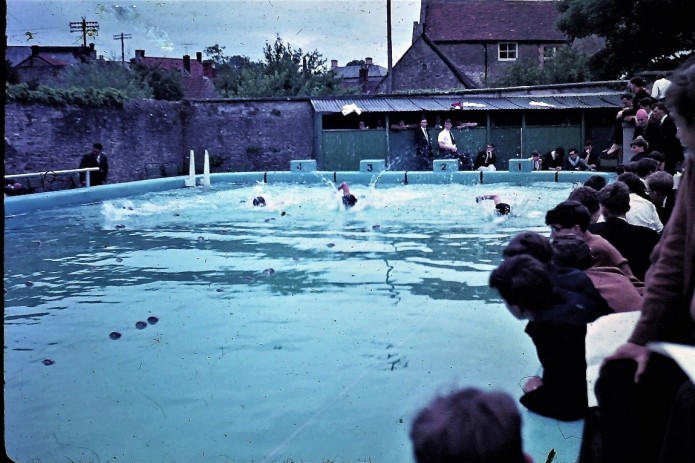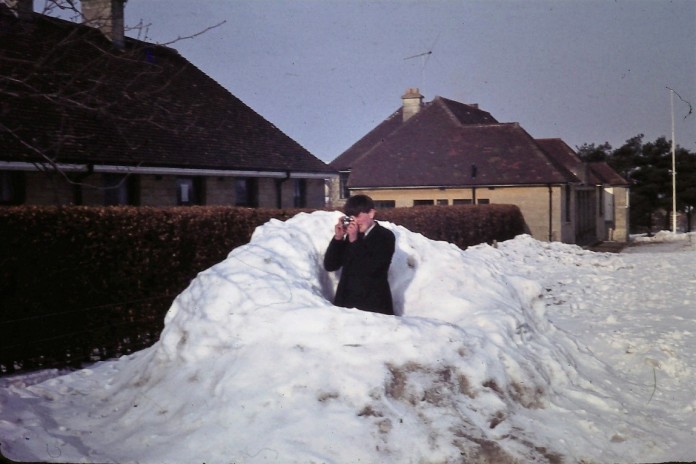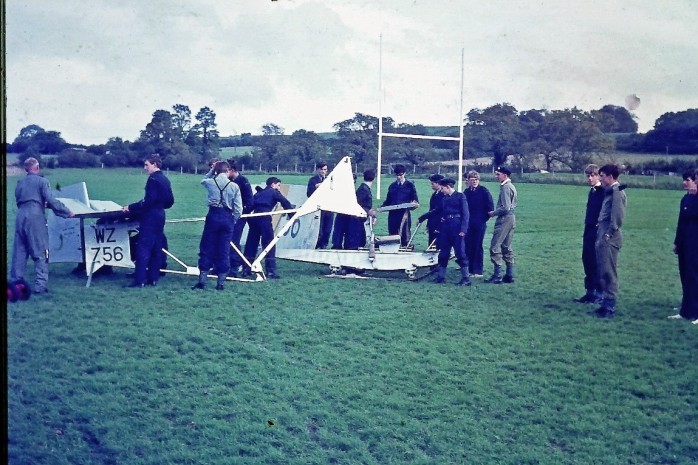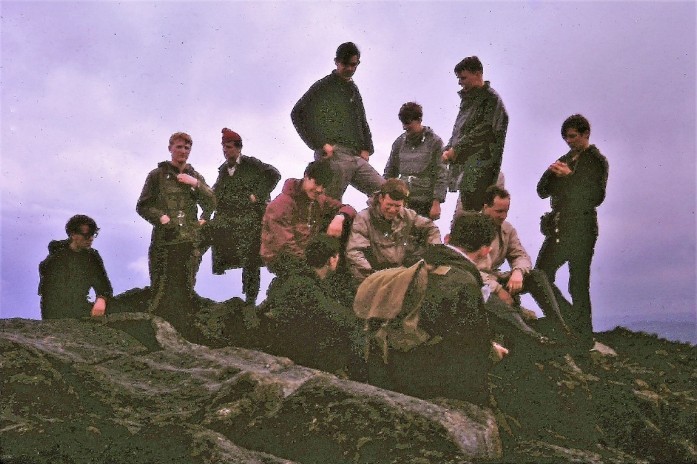Part of this article was featured in the Old Brutonian Association magazine 2020.
Swimming Sports Day, 1961
I think this was my first term (I arrived in the Summer Term). There’s not much to say: it was the inter-house swimming competition.

1st XV match c.1962
Like all 1
st matches this was on the pitch, on Hyde, adjacent to Lyon House.

School Skiing Trip-1963
The irony of this trip is that we left the country on the very morning following the arrival of the ferocious blizzards that hit southern Britain that winter. In consequence, quite a few of us had difficulty reaching the departure point of Victoria Station at the appointed hour (I think it was about 7am). Then after a Dover/Calais ferry journey, we steamed through the night across a bitter snow-bound Europe. The weather outside the train was in stark contrast to the climate in the carriage: it was bakingly hot on my top couchette
After leaving the train we arrived in a little village in the Tyrolean foothills to find that the pass to our resort had been blocked by avalanches. This led to an agreeable over-night stay in a small village inn. After the snow ploughs had been working through the night we eventually arrived in our resort which turned out to be the beautiful little village of Vent, 6000 feet up in the Oetztal Alps. At that height there was normally no difficulty with snow, but that winter there was a lot more than usual.
It will not escape your notice that there is a girl in the front row of this group photo; this was unusual and something of a culture-shock to us at the time (she was not the only one, by the way). This came about because Mr. Hollander, the King’s biology teacher, had a family contact with a girls’ school in Exeter (I think it may have been called St. Margaret’s, but I cannot be sure) – so in this way, the trip became a joint one.
Mr. Hollander, an affable and agreeable man, managed us with a light hand. Also on the trip were some other members of Mr. Hollander’s family not the least being his attractive wife for whom we all had a soft spot.

School in Winter 1963
On return from Austria we were delighted to learn that the beginning of term had been delayed for about a week: apparently some of the houses had burst water pipes and access to Bruton was difficult because of snow on road and rail. When we eventually arrived the cold was intense, and that is my abiding memory of that winter.

In Lyon House, at that time, there was no central heating and the two large curtainless, carpetless and, it has to be said, completely charmless, twenty bed dormitories. They each had one small electric fire on the ceiling (since heat rises this was probably not the best place for a heater). Mr. Moreton, our housemaster would occasionally struggle to light a fire in our day-room but it gave off very little heat. Apart from this, after some days, a huge grain dryer arrived in the wash-room. This resembled a very noisy jet engine which chucked out a lot of heat but only in its immediate vicinity – so for a time the washroom became the centre of social life; we just had to stand there and talk very loudly to each other. It now occurs to me, a little late in the day, that the grain dryer may have been more about keeping pipes unfrozen than our personal welfare – the naivety of youth!
We worked out a strategy for getting up in the morning without exposing too much flesh to the bitter cold in the dormitory: day clothes were taken under the blankets and about ten minutes later we emerged substantially clothed (including the separate collars and collar studs of the time) and ready to face the chill of the walk down across Abbey to the dining-hall for breakfast. At the beginning of term everything in and around Bruton was covered in deep snow. This was when I took the rather badly exposed pictures of sledging and skiing on Pigeon Tower (do people still call it that, as we always did, or is it now just the Dovecot?). Those of us who had been on the skiing trip were particularly keen to show off our newly acquired skills.

Keith Warren-Price - I think!
There was only one pair of skis in the school and it belonged to the ever-obliging Mr. Hollander, who was foolish enough to lend them to us from time to time.

Peter Quincey - Lyon House

This is the remains of an igloo built outside Lyon House, once the thaw had started and the roof collapsed. Michael Warmick is the 'inmate'.
Because of the continuing intensity of nightly frost, the snow stayed around for a very long time – I think it was not until towards the end of March that it completely disappeared. This made games on the playing fields out of the question. So, games afternoons consisted of numerous cross-country runs interspersed with various boisterous activities in the gym (heaven forbid that we should ever be allowed any free time!).
A favourite pastime (well, with those in charge of games, anyway) was ‘Hare and Hounds’ which involved two or three boys (usually the fit ones) setting off across the snow patch-worked fields and woods around Bruton with a piece of chalk which was used to mark arrows on gate posts, stiles etc.; and the rest of the school setting off in pursuit a little later using the chalk marks as the clues to follow the 'hares'. It has to be said that none of this was taken as seriously as it should have been, most of the ‘hounds’ regarding it as a welcome opportunity for a relaxing stroll through the countryside; the ‘hares’ were very rarely caught.
Cross-country was taken more seriously. The phoe below shows Michael Roberts, a liekable chap from Lyon Hous and the star of the cross-country team. There was little doubt that he would have been ahead of everyone else.

Michael Roberts - the star of the cross-country team
By way of a diversion, and in reference to the term ‘Pigeon Tower’, as my contemporaries will recall, in the early 1960s ‘A Pigeon Tower’ was also a unit of punishment (in Lyon House, anyway): if, in the eyes of a prefect, you had committed a misdemeanour (for example talking during prep) then you may be given ‘a Pigeon Tower’. What this meant was that you had to change into your games kit, set off from Lyon House, run round Park Wall, then up the hill to the Dovecot and back to the house: and depending on the severity of the offence, you may be ‘sentenced’ to one, two, or three ‘Pigeon Towers’ as the case may be.
The really clever bit about all this was that it could be monitored by the prefects with no more effort than breaking off from their tea and toast, walking round the side of the house to see the silhouette of your exhausted figure struggling up towards the tower in the gathering dusk. This was, of course, important as otherwise, there was the strong risk that, once outside the house gate, you may simply head for the nearest hedge for a cigarette.
For some reason all this changed during my period at King’s. When I arrived such rituals, along with fagging, were important parts of the culture of the school. But by 1965 these things, along with the absolute and unassailable power of the prefect, had all but disappeared (and a very good thing too, in my personal opinion) and the focus, and also it must be said, the pressure, had turned in the direction of getting us through our A Levels and into university. Why and how did this happen? I don’t know – perhaps it was part of wider social and cultural change at that time.
CCF General Inspection-c.1963

On Abbey Playing Field.
At that time everyone in the school was in the CCF whether they liked it or not – claiming to be a ‘conscientious objector’ was not acceptable. There was later an exception for the Upper Sixth (I think). In your first term you were classified as ‘a recruit’ and as, at that stage, you had no uniform, you wore a cricket jumper and school cap, as you can see above.

The C.C.F. R.A.F. Section Glider

Quite a lot of head scratching
There were a few, such as Group Captain Smyth (ex-jet fighter and my chemistry teacher) along with the odd future airline pilot in our ranks, who managed to take to the air in this lethal contraption, sail across Hyde field with effortless swallow-like grace and land it with the precision of a feather on a postage stamp. But to most of us it was an object of sheer terror. The whole concept seemed to be based on the highly suspect notion that if you had chosen to join the R.A.F. section of the C.C.F. then it must follow that you had a natural aptitude to pilot an aeroplane.
On corps days, we would assemble on Hyde by the shed where the glider was kept, get it out and put it together (this had to be done each time it was used). It was basically a single frame with a seat stuck on top with wings on top of that. It was slid to the end of the field; an iron stake was then driven into the ground and the glider attached to it by a rope. The front of the plane was then attached to a bungee rope in two strands. Two teams, of about six boys, then took up a strand each and walked away from the glider thereby creating an enormous elastic catapult. When the tension was deemed sufficient, the ‘pilot’ shouted ‘stop’, pulled a lever under his seat which released it from the iron stake and the glider surged forward. On the first few occasions you did this ‘spoilers’ (i.e. planks of wood) were attached to the leading edge of the wings so you just slid along the ground, the challenge at that stage being simply to keep the wings level – not as easy as it sounds, at least, for most of us.

When you had done this six times (I think it was) you were deemed a fully qualified pilot, the spoilers were removed and up you went. Unless of course you could avoid it: I don’t think I was the only one who, when asked: “Gooding, how many times have you done a ground slide?” had answered: “Oh, it’s about four or five times, sir, I think”.
But it caught up with you eventually, and on this particular afternoon it was the nemesis of one boy who will to me forever be a hero.The glider was duly prepared in the usual way and as it was this boy’s unlucky afternoon, the spoilers were removed. Now, if you can imagine the glider as an enormous paper dart; you will remember from your childhood that if you throw the dart too hard it has a tendency to shoot up towards the ceiling whereupon it drops vertically towards the floor. This, in simple terms, is known technically as a ‘stall’ and it is, more or less, what happened that afternoon: the pilot shouted ‘stop’, the glider shot forward, and, exactly as required, he pulled on the stick. However, the real difficulty is knowing exactly when to put the stick forward again and level out. So, up and up went the glider and then down and down it fell with a spectacular and bone-crunching crash, snapping both wings and breaking the fuselage in two.

And what about the pilot? I’m sure he would have been pleased at your concern as everyone else seemed too busy fussing around the aircraft to bother about him. Thankfully, although he was rather shaken, he was completely unhurt. And it was a sign of the times that I don’t think it occurred to anybody that, perhaps, he ought to see a doctor.
School Sports Day c.1963
In the background of the first photo you can just make out the work being carried to extend Hyde Field into what later became, at that time anyway, ‘Farr Field’. The field had been levelled and pushed up to form a bank to the right and it appears that the grass is yet to be sown.
I also remember that, by way of a welcome break from routine, on two days at least the whole school was turned out to walk slowly in an extended line across the, as yet, uncultivated field picking up stones.

A Level Combined Geography and Biology Field Trips, Easter 1964 and Easter 1965
Both of these highly enjoyable trips were made during the Easter holiday, our base being a hostel in the tiny hamlet of St. John’s-in-the-Vale just outside Keswick. There were no frills in our accommodation: we slept in bunk beds with about six of us per room; but, frankly, compared to the Lyon House dormitory, it was pampered luxury. We had exclusive occupation of the hostel and had to prepare our own meals. This was organised by rota with about four of us at a time on duty to do the cooking and clearing away.
I was in the geography group and we spent our days taking bearings, learning how to draw maps and, in particular, plane-tabling – as below:

We also visited geological features such as Malham Cove and looked at glacial features in which Somerset is sadly lacking. The biology group did equivalent biological things which often seemed to involve taking quantities of water from a lake in glass jars and then examining it under a microscope. On other days we would climb a mountain; and in this way, we scaled Helvellyn, Skiddaw, Great Gable and the Langdale Pikes, among others.
There were two teachers with us, the estimable Mr. Hollander in charge of biology, and Mr. Setchel in charge of geography. Mr. Setchel was a brusque Yorkshireman who could be a little intimidating when you first met him. But it didn’t take long to warm to him and to his rather dry sense of humour; we all came to like and respect him a lot.
 I believe it was on these two trips that I first became conscious of a subtle change in relationship with our teachers; I suppose it was because we were in the Sixth form that we were first treated as people at least approaching adulthood. One way this manifested itself was on our rare evening trips to the bright lights of Keswick: with a wink and a nod, Mr. Hollander and Mr. Setchel would, very pointedly, tell us not only which pub they were going to but which bar (the lounge rather than the public bar in their case, of course). In other words, we could go to any bar we liked as long as it wasn’t the one they had chosen. In this way, the embarrassment of a meeting, and any risk of this getting back to the school, was avoided. For one thing, I think we were all under eighteen. A rendezvous point was arranged for the end of evening and we all headed back to the Hostel in the Dormobile with one of the teachers at the wheel.
I believe it was on these two trips that I first became conscious of a subtle change in relationship with our teachers; I suppose it was because we were in the Sixth form that we were first treated as people at least approaching adulthood. One way this manifested itself was on our rare evening trips to the bright lights of Keswick: with a wink and a nod, Mr. Hollander and Mr. Setchel would, very pointedly, tell us not only which pub they were going to but which bar (the lounge rather than the public bar in their case, of course). In other words, we could go to any bar we liked as long as it wasn’t the one they had chosen. In this way, the embarrassment of a meeting, and any risk of this getting back to the school, was avoided. For one thing, I think we were all under eighteen. A rendezvous point was arranged for the end of evening and we all headed back to the Hostel in the Dormobile with one of the teachers at the wheel.

This same Bedford Dormobile provided the transport from and to Somerset. Looking at the picture of it now I cannot see any possible way that we could have all got into it – maybe some boys came by other transport; I cannot now remember.
Looking at these photos now, most of them actually for the first time in over fifty years, has been a strange and quite unnerving experience. Certainly, the old cliché about remembering those distant times like they were yesterday whilst not actually remembering yesterday comes to mind. Other than that, perhaps it is wise not to indulge in too much introspection.
It is enough simply to say that I spent four and a half very happy and companionable years at King’s and it provided me with the best training for life I believe I could have had anywhere. But the most important thing it provided was an unrivalled education from the brilliant and inspiring, albeit quite often eccentric, teachers.
Do you have memories or photos of your time at King's? If so, we would love to hear about them. Please email oba@kingsbruton.com. Thank you!


















